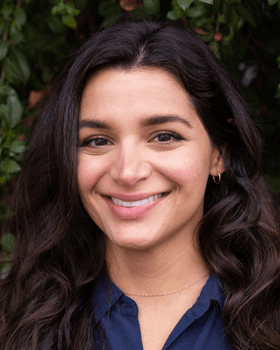States Convene in Washington to Discuss Navigating Energy Trends and Federal Programs
On May 28 and 29, 2025, the 2025 National Energy Summit for States took place in Washington, D.C., organized by the Clean Energy States Alliance (CESA) in conjunction with the National Association of Regulatory Utility Commissioners (NARUC) and other organizations. The Summit brought together state and federal energy officials, nonprofit leaders, researchers, and industry experts to discuss pressing issues at the intersection of energy deployment, grid reliability, affordability, and equity. Over 250 officials and experts attended the Summit, representing 34 states from across the country. The event featured interactive breakout sessions, technical panels, and peer-to-peer exchanges, with a particular focus on the implications of evolving market structures and opportunities for innovation and collaboration.
The Summit offered critical insights into the evolving energy landscape. State and federal leaders discussed actionable solutions to manage load growth, enable innovation, support underserved communities, and ensure equitable, reliable energy deployment. The Summit reinforced the need for collaboration, regulatory modernization, and robust public engagement.
Below are summaries of the sessions held at the Summit, highlighting major takeaways from panelists’ presentations, points of agreement and disagreement in attendees’ discussions, and state and federal needs as energy programs are designed and implemented across the US.
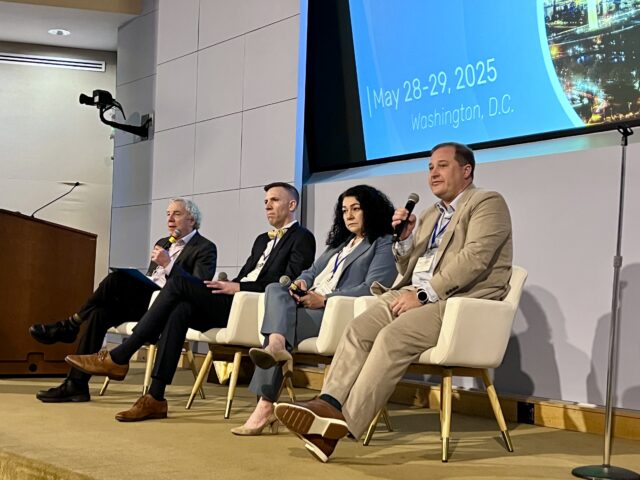
Opening plenary from left to right: Warren Leon (CESA), Philip Bartlett (Maine PUC), Angie Hatton (Kentucky PSD), Peter Ledford (North Carolina DEQ).
Opening Plenary: Energy Affordability
The Summit opened with a panel discussion featuring Philip Bartlett of the Maine Public Utilities Commission, Angie Hatton of the Kentucky Public Service Department, and Peter Ledford of the North Carolina Department of Environmental Quality, with CESA Executive Director Warren Leon as moderator. Panelists discussed the many dimensions of energy affordability, including the desirability of reducing electricity costs for all customers, strategies for ensuring that there will be enough electricity supply that prices will not unnecessarily spike, and the need to make energy affordable for low-income customers. It was noted that different organizations and different states may focus on different dimensions of the topic. The panelists noted that energy affordability was a top priority for their states and argued that it should and will likely be a major focus for other states. Nevertheless, they explained how it can be challenging for states to address affordability, because there are limits to how much control they have over fuel costs, construction costs, and wholesale and retail electricity prices.
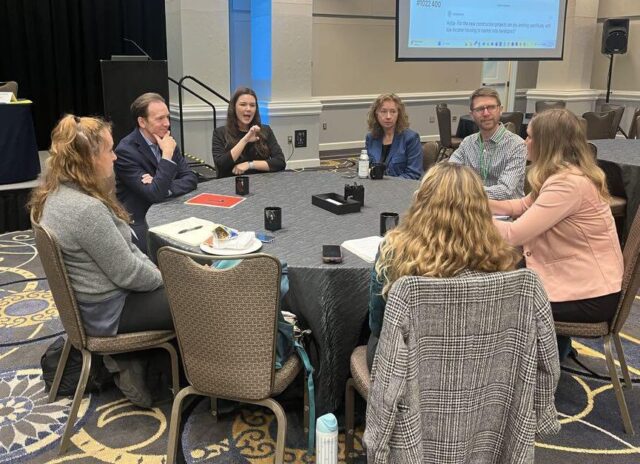
Attendees discuss energy concerns with other states in networking breakout groups.
Small Group Networking Breakouts
Attendees were divided into nine small discussion groups. This informal session allowed attendees to exchange experiences and challenges related to affordability, resilience, and the impacts of load growth. Participants expressed a desire for enhanced organizational and funding landscape mapping, building on CESA’s federal and state initiatives efforts. Concerns emerged over rising energy bills and predatory practices by third-party suppliers in restructured states. Participants highlighted the complexity of coordinating low-income programs, the need for consumer protections, and the challenge of ensuring equitable program delivery, particularly in rural areas.
Load Growth: What States Need to Know
This session featured a panel discussion with Jonathan Koomey of Koomey Analytics and Bruce Tsuchida of The Brattle Group, moderated by Carrie Hearne of the Virginia Commission on Electric Utility Regulation. Panelists explored the drivers of recent and projected electricity load growth, particularly data center expansion. It was emphasized that some states will experience much more load growth than others. Virginia was highlighted as a key example, responsible for a significant share of US and global data center capacity. Speakers emphasized the uncertainty in load growth forecasts and the importance of understanding embedded assumptions. The risks of under- and over-forecasting were discussed, with recommendations to adopt flexible, assumption-sensitive planning tools.
Energy Tax Credits Status Update
At this session moderated by Vero Bourg-Meyer of CESA, speaker Keith Martin of Norton Rose Fulbright offered a detailed overview of the status and implications of federal energy tax policy. While many incentives were preserved, new compliance requirements and complexities, including those related to foreign entities of concern (FEOC), raised potential barriers. Martin highlighted expected timelines for legislative developments and fielded audience questions about direct pay eligibility and tariff implications.
Facilitating Community Engagement in Project Development
This session featured Tamara Ogle of Purdue University, Damian Pitt of Virginia Commonwealth University Institute, and Ryan Trauley of the Maryland Energy Administration. It was moderated by Jonathan Morgenstein of the National Renewable Energy Laboratory (NREL). Panelists addressed the importance of early and authentic community engagement in energy project development. Panelists discussed widespread local suspicion toward solar projects and emphasized that community engagement must go beyond simple outreach. Trusted community-based organizations, faith leaders, and individual navigators were highlighted as essential intermediaries for translating technical and policy language into meaningful information for residents. Speakers stressed the need for energy advisors to serve as ongoing resources throughout project implementation—coordinating contractors, identifying funding, and ensuring transparency about what support is available and when. The conversation included program design strategies to reduce administrative burdens on both installers and participants, and the value of flexibility within procurement processes, such as waiver considerations. Empowering communities to make their own decisions, think critically about project alternatives, and build networks of peer engagement were seen as keys to long-term success and equity in deployment.
Working with FERC: How and Why
This session featured Yewande Bayly and Rob Thormeyer of the Federal Energy Regulatory Commission and Christina Hayes of Americans for a Clean Energy Grid, and was moderated by Ben Paulos of CESA and PaulosAnalysis. The discussion helped demystify the role of the Federal Energy Regulatory Commission (FERC) for state audience members, emphasizing its quasi-legislative and quasi-judicial authority. Presenters discussed FERC’s evolving role in transmission siting, regional planning, and wholesale market oversight. The importance of engaging with FERC’s Office of Public Participation and Office of External Affairs was stressed, particularly to elevate state and public voices in policy development.
Actions States Can Take to Address Load Growth
This discussion featured Daniel Hopper of Southern California Edison, David Springe of the National Association of State Utility Consumer Advocates, and Jason Stanek of PJM Interconnection. It was moderated by Angela Navarro of ALN Policy and Law. The session focused on how states can manage and mitigate the impacts of growing electricity demand. Topics included cost allocation strategies, risk minimization techniques, and ensuring affordability amidst infrastructure expansion. Participants debated who should bear the costs of new load, particularly from large customers like data centers. There was agreement that cost causation principles should guide policy. Speakers emphasized the need for flexible demand-side solutions and modular resource planning portfolios.
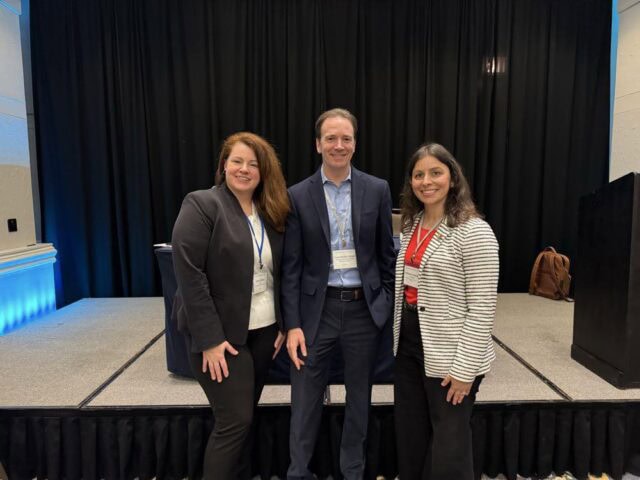
Panelists of “Home Energy Strategies and Best Practices” from left to right: Anita Wilson (Georgia Environmental Finance Authority), Forest Bradley-Wright (ACEEE), Melissa Cheatham (S2 Strategies)
Home Energy Strategies and Best Practices
This session featured Forest Bradley Wright of the American Council for an Energy Efficient Economy and Anita Wilson of the Georgia Environmental Finance Authority, moderated by Melissa Cheatham of S2 Strategies. It focused on the implementation of the U.S. Department of Energy’s (DOE) Home Energy Rebates program and other efficiency incentive programs. Best practices for engaging low- and moderate-income households were discussed, including strategies to balance bill assistance with long-term efficiency investments. Speakers noted the challenge of reaching underserved populations and the importance of community-based outreach and trusted messengers.
Geothermal Opportunities
This panel featured Anna Holmstead of the Utah Office of Energy Development, Zeyneb Magavi of the Home Energy Efficiency Team (HEET), and Sean Porse of the U.S. Department of Energy. It was moderated by Ben Paulos of CESA and PaulosAnalysis. Panelists explored geothermal innovations in heat pumps and drilling that are expanding opportunities for clean heating and power. Speakers discussed recent technology and policy advances. Panelists considered barriers to commercialization and mitigation strategies, and outlined actions states can take to support geothermal deployment.
How Grid Operators Manage the Grid
This discussion, lead by Paul Denholm of and moderated by Sam Schacht of CESA, provided a primer on grid operations and the challenges posed by increasing renewable penetration. Denholm explained the concepts of resource adequacy and operating reliability, and how these are evolving with the shift from fossil-based baseload systems to variable renewable energy. The session emphasized the value of geographic diversity, energy storage, and flexible dispatch in managing variability. A key takeaway was that expanding grid interconnections and enhancing operational flexibility can help mitigate the challenges of renewable variability.
Meaningful Household Savings on Solar
This session featured a conversation with Jonathan Abe of Sunwealth and Kyle Wallace of PosiGen, moderated by Vero Bourg-Meyer of CESA. Panelists examined how solar programs can be designed and evaluated to ensure meaningful household savings. The discussion covered a range of solar project types—including community, rooftop, and multifamily solar—and highlighted approaches to improve cost-effectiveness and equity. Panelists considered how to define “meaningful savings,” in addition to considering case studies, specifically in the context of low to moderate income community solar. Partnering with communities was also emphasized and explained as being essential to successful savings and programs.
State-Tribe Collaboration
This panel featured Claudio Clini of the Alliance for Tribal Clean Energy and Chris Descheneo of the National Inter-Tribal Energy Council, moderated by Wendolyn Holland of the Alliance for Tribal Clean Energy. The session underscored the importance of meaningful partnerships between states and Tribal nations. Tribes were identified as critical stakeholders in energy development, often operating with limited administrative capacity but deep local knowledge and ambition. Presenters urged early, respectful engagement and acknowledged the historical and jurisdictional complexities involved. Programs supporting Tribal energy sovereignty and capacity-building, such as TACE in Minnesota, were highlighted.
Transmission
This session featured Josh Rogers of the Great Plains Institute, Elizabeth Salerno of GQS New Energy Strategies, and Beth Soholt of Clean Grid Alliance. It was moderated by Gretchen Kershaw of Grid Strategies LLC. Panelists explored the pressing challenges and critical opportunities in modernizing the nation’s transmission system. The discussion highlighted the advantages to a nationally mandated approach to transmission planning and emphasized the crucial role of states in shaping and executing those plans. FERC Order No. 1920 was discussed in detail, including its requirements for long-term, comprehensive planning horizons, evaluation of multiple transmission drivers (such as fuel cost trends and electrification mandates), and broader consideration of transmission benefits. MISO’s long-range transmission planning was cited as a leading example of how these principles can be applied in practice. Several barriers were explored, including utility disagreements over load forecasts and the systemic issue of inadequate transmission capacity as the primary cause of interconnection queue delays. The panel also addressed common drivers of local opposition to new transmission lines, stressing the need for proactive and transparent community engagement. Community buy-in was presented not only as a best practice but as essential to the success of any large-scale transmission project. Overall, the session called for coordinated, forward-looking planning and emphasized that transmission must be treated as a foundational piece of national infrastructure—on par with highways and broadband—and supported with sustained policy attention and public trust.
Virtual Power Plants
This session featured a discussion with Sergio Carrillo of the Connecticut Green Bank and Hanna Jones and Todd Olinsky-Paul of CESA, moderated by Seth Mullendore of Clean Energy Group. It examined the growing role of virtual power plants (VPPs)—aggregations of distributed resources that function as local generation. Panelists considered what counts as VPPs, the legislative and regulatory support behind them, and program designs and dispatch. The session covered various VPP models, characteristics of currently operating battery VPPs, and implementation strategies for state agencies. Case studies, including the California Self Generation Incentive Program (SGIP) and the Connecticut Energy Storage Solutions program, provided insights into user experiences, benefits, and best practices.
How to Compensate DERs for Location-Specific Services
This session featured a presentation by Corrin Moss of the Massachusetts Clean Energy Center and focused on compensation mechanisms for distributed energy resources (DERs) that provide location-specific grid services. Moss discussed program design strategies that reflect the localized value of DER deployment and integration.
1-1 Office Hours: Technical Assistance for States
Representatives from national labs and NGOs provided states with customized technical assistance. Topics included building upgrade affordability, incentive stacking, low-income solar+ program design, rate and market design, energy tax credits, funding application support, and more.
State Consumer Protection Measures
This session showcased a presentation by Sarah Duffy of the Illinois Power Agency (IPA) discussing consumer protection best practices developed by the IPA. Duffy identified key considerations for states developing solar, efficiency, and home energy programs, and shared implementation strategies to protect participants from fraud and misinformation.
CAIRO Tool, Rates Design, and Electricity Markets
This session featured a presentation by Thomas Bowen of NREL introducing state policymakers to the CAIRO model (Customer Affordability, Incentives, and Rates Optimization), a tool developed by NREL to evaluate impacts of residential electric utility rate proposals on customers and the grid. Bowen explained how evolving power system dynamics—including rising electricity demand from data centers and electrification, and the proliferation of DERs—are challenging traditional flat-rate designs. The CAIRO tool was presented as a resource for states to analyze complex trade-offs with rate design options, such as improving affordability, reducing cost-shifting, and facilitating DER integration. Bowen demonstrated how the tool enables side-by-side comparisons of rate designs across multiple metrics aligned with Bonbright Principles, regulatory criteria, and customer demographics including low-income and DER-adopting households. The session included examples of how CAIRO integrates with other NREL models to simulate system-wide impacts of rate reforms and assess potential changes to net metering, demand flexibility, and bill assistance programs.
The Art of Stacking
At this session, Alisa Petersen of the Rocky Mountain Institute (RMI) presented strategies for combining federal, state, and local incentives to maximize program impact. Petersen considered what counts as stacking, its benefits, and which funds can stack to provide those benefits to consumers. Petersen emphasized coordination and timing in incentive design to optimize benefits for both implementers and participants.
NCSP+, SAM, and ReOpt Tools
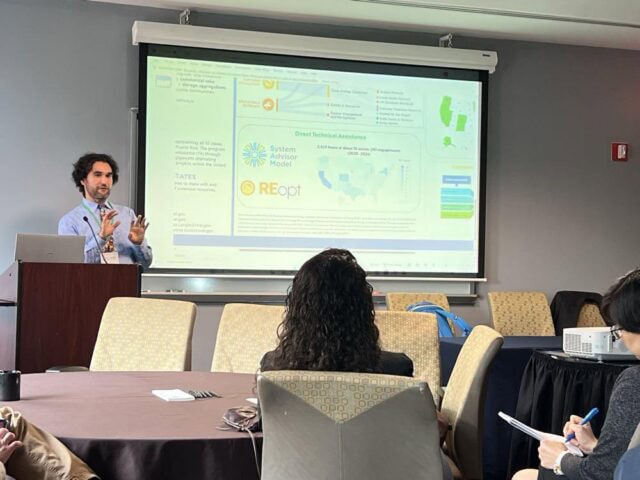
Simon Sandler presenting NREL’s SAM and ReOpt tools.
This session showcased a presentation by Sandler of on the National Community Solar Partnership+ (NCSP+), a U.S. DOE initiative that expands access to affordable, distributed solar energy. Sandler discussed NCSP+ as a multi-faceted coalition supporting community-led solar deployment through a range of programmatic pathways. These included: Direct Technical Assistance, which offers modeling support using tools like the System Advisor Model (SAM) and REopt; peer learning through the States Collaborative; customer engagement via the Clean Energy Connector platform; and project financing resources offered through the Community Power Accelerator. Sandler also emphasized the program’s focus on enabling communities to realize the full benefits of solar—such as bill savings, energy resilience, economic development, and workforce growth—through collaborative learning and an active online community forum. The session demonstrated how state and local actors can leverage NCSP+ resources to accelerate equitable community solar deployment and achieve broader clean energy goals.
Technical Assistance with Sandia National Laboratories
This session featured presentations by Dylan Poindexter and Will McNamara of Sandia National Laboratories. It detailed Sandia’s technical assistance offerings for state energy agencies, focusing on energy storage regulation, economics, and technology. The presentation included examples of prior engagements and described how Sandia helps state officials integrate energy storage solutions into policy and operations.
Programs from Minnesota and Rhode Island
This session featured presentations by Shauna Beland of the Rhode Island Office of Energy Resources, Karen Stewart of Rhode Island Commerce, and Leah M. Wilkes of the Minnesota State Energy Office. Presenters shared program models from Minnesota and Rhode Island, including Minnesota’s Regional C-PACE and Revolving Loan Fund and Rhode Island’s Clean Energy Internship Program. Panelists discussed program design, funding structures, and lessons learned in implementation.
Promoting Innovation by States: A Roundtable Discussion
This session featured roundtable discussion with Richard Bourgeois of the New York State Energy Research and Development Authority (NYSERDA), Sara Harari of the Connecticut Green Bank, Galen Nelson of the Massachusetts Clean Energy Center, and Cammy Peterson of the California Energy Commission. It was moderated by Warren Leon of CESA. State representatives discussed how their agencies support technological, financial, and programmatic innovation in energy technologies. The discussion covered public-private partnerships, innovation incubators, and cross-state collaboration. Speakers emphasized the importance of incremental and disruptive innovation, and the role of state support in advancing market readiness for emerging technologies.
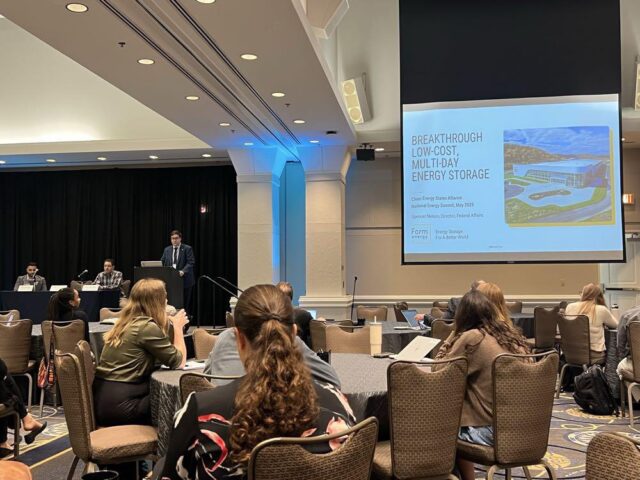
Spencer Nelson (Black & Veatch Corp.) presenting at “The State of the Art in Energy Storage.”
The State of the Art in Energy Storage
This technical session featured a conversation with Paul Denholm of NREL, Spencer Nelson of Black & Veatch Corporation, and Prantik Saha of Form Energy. It was moderated by Seth Mullendore of Clean Energy Group. The session delved into the categorization, performance, and market readiness of various energy storage technologies. Presenters discussed the role of short, medium, and long-duration storage in enhancing grid reliability and integrating renewables. Iron-air batteries, thermal storage, and flow batteries were evaluated for different applications. Discussions also addressed the implications of battery chemistry, safety, and regulatory treatment.
Demystifying State Activities for Supporting Advanced Nuclear
This session featured Reed Clay of the Texas Nuclear Alliance, Francisco Ralston Fonseca of the Electric Power Research Institute, and April Wade of the Virginia Nuclear Energy Consortium. It was moderated by Kathryn Kline of NARUC. The session highlighted 2024 as a pivotal year for advanced nuclear development, driven by rising load forecasts from data center expansion and domestic industrial growth. Panelists discussed new DOE funding for Gen III+ nuclear projects and increasing interest from large tech firms. Drawing from NARUC’s Advanced Nuclear State Action Tracker, speakers provided state-specific updates on planning and deployment activities. The discussion also covered the current status of existing nuclear facilities, including considerations around reopening shuttered plants.
The Role of Local Resources
This session featured a conversation with Emile Thompson of the District of Columbia Public Service Commission and Pete Wyckoff of the Minnesota Department of Commerce, moderated by Stacey Paradis of the Illinois Commerce Commission. The discussion explored how local resources—such as distributed generation, energy storage, microgrids, and demand flexibility—can improve grid reliability and resilience, often at lower cost than traditional infrastructure. Panelists examined regulatory and policy pathways to support deployment, emphasizing benefits to customers in the form of bill savings and increased energy security.
Solving Barriers to Energy Development
This session featured Lakshmi Alagappan of E3, Rob Gramlich of Grid Strategies, and Jessica Waldorf of the New York State Department of Public Service. It was moderated by Ben Paulos of CESA and PaulosAnalysis. Panelists addressed structural challenges impeding energy project development. Topics included findings from an E3 survey on state siting and permitting policies, proposed interconnection queue reforms from Grid Strategies, and insights from the Northeast States Collaborative on Interregional Transmission. The session emphasized multistate cooperation and regulatory innovation to accelerate project timelines.
What States Are Doing About Energy Storage
This session featured Erin Ferrel of the Maine Governor’s Energy Office, Jeremy Lewis of the New Mexico Energy, Minerals and Natural Resources Department and David Comis of the Maryland Energy Administration. It was moderated by Will McNamara of Sandia National Laboratories. The discussion highlighted state-led efforts to support energy storage through procurement, regulation, and technical innovation. State efforts were highlighted, and panelists examined how governance structures (restructured vs. vertically integrated) shape state approaches. The importance of understanding the locational value of DERs for resilience and cost-effectiveness was emphasized. Participants discussed how federal policy changes (e.g., tariffs or ITC reductions) could affect state strategies and the need to adapt. VPPs, behind the meter visibility, resilience hubs, and electrification strategies using storage were explored as evolving areas of focus. All states agreed on the need for better planning tools and emphasized continuing federal-state collaboration to scale energy storage.
Published On
July 14, 2025

